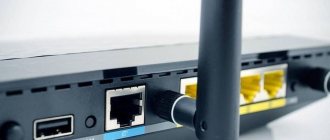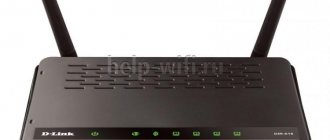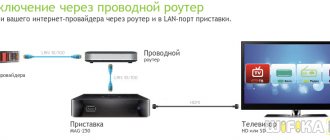Today it is difficult to imagine everyday life without the Internet. People use it not only at home, but also on the street. There are many different ways to connect to the global network. Some use pocket Wi-Fi for this, which allows you to use the Internet anywhere.
Pocket Wi-Fi provides access to the Internet even in nature
Types of routers
There are three main types of routers:
- Ethernet routers . This is a type of router familiar to most users, which connects to the provider via twisted pair cable. A special cable is installed in your apartment or office, providing data reception and transmission at speeds of up to 100 megabits per second. This cable connects to the router, which then distributes the Internet to your computer, laptop and smartphone. Older models were not equipped with a Wi-Fi module, so client devices were also connected to them using twisted pair cables. Modern devices operate in wireless network mode and can be connected to them over the air.
- ADSL routers . They are a hybrid of an ADSL modem and a router. They receive Internet from a telephone line and then distribute it via cable or Wi-Fi.
- LTE router . This is a portable portable router that works in 3G and 4G mobile networks. This router does not need wires. It receives the Internet over the air in the coverage area of the mobile operator, and then distributes it over the air to other mobile devices in the same way.
It’s the third type of router that we’ll be talking about.
What is a pocket Wi-Fi router
A portable (pocket) Wi-Fi router is a portable router that converts 3G and 4G signals into Wi-Fi coverage. As is the case with ordinary network equipment, a certain number of smartphones, tablets, computers, etc. can be connected to this device.
Appearance of a pocket Wi-Fi router from TP-Link
The device is small in size and easily fits in a person’s palm or jeans pocket. Due to its small size, pocket Wi-Fi is convenient to take with you on trips or business trips. If, for example, you put a remote access point in a backpack, the coverage radius will fluctuate within 10-15 m from it.
There are several types of mobile routers:
- depending on the place of use, type of connection and power source, it is divided into mobile and stationary;
- modifications equipped and not equipped with connectors for additional use of an external antenna;
- Depending on the type of network, CDMA, GSM, HSDPA or two-standard are used.
Stationary modifications of network equipment are characterized by a large wireless network coverage radius. Operates only from a 220 W network continuously throughout the day, equipped with a USB connector.
A mobile router, as mentioned earlier, has a very compact size, so it can be easily and simply used in a car, subway, traveling, etc. Mobile devices operate on a rechargeable battery and are equipped with built-in signal receivers.
Note! The results of the checks showed that the maximum coverage of manual Routers is provided by the operators People.Net and Intertelecom, so when choosing network equipment it is better to give preference to CDMA routers. If there is no coverage, then an ordinary SIM card is inserted, and you can use the services of GSM operators.
An example of the technical characteristics of a pocket Wi-Fi
Purchasing a pocket router can be a bit challenging, as the range is quite large, as is the price range. Pricing depends on the following factors:
- battery capacity;
- manufacturer;
- Pocket Portable dimensions;
- Possibility of connecting an additional external antenna to enhance the communication signal.
Important! It is worth considering that the price of a pocket Wi-Fi is not only the cost of the equipment itself, but also the cost of the mobile Internet used to access the Global Network.
Advantages and disadvantages of this device
A portable Wi-Fi router has many advantages, but when purchasing this device, you need to become familiar with the main disadvantages of using it.
The main advantages of this type of network equipment:
- ability to connect to a computer via a USB cable;
- capable of supporting any communication standards (LTE, CDMA, HSDPA, GSM);
- the ability to use high-speed Internet anywhere there is mobile coverage;
- the ability to use the Internet simultaneously from several devices;
- a wide range of devices with various modifications;
- large range, some pocket routers extend the signal up to 30 m;
- The operating time without recharging is about 15 hours.
Operating principle of a pocket router
As for the shortcomings, users note the following:
- some modifications may work unstably in rooms with high air temperatures and high humidity levels;
- a person additionally needs to carry another device in his pocket, hands or purse;
- As practice shows, the duration of the router's offline operation is less than the stated hours. Typically the battery charge lasts for 2-5 hours;
- no auto-shutdown mode.
Note! They also note the fragility of some cases, which can lead to equipment failure during operation.
Why do you need a pocket router?
Today, mobile Internet is still expensive and in comparison with wired data transmission. However, it is indispensable on the road or, for example, in the countryside, where a wired connection is not available. Wherever your mobile operator has coverage, the Internet will work one way or another.
Almost all mobile users use mobile Internet on their phones. To do this, you do not need to purchase additional devices - any modern smartphone copes with this task perfectly. Then why do you need a pocket Wi-Fi router?
Let's look at the main reasons for using:
- A portable router allows you to organize access to the Internet from several devices at once, regardless of which tariff of which operator is used for them. And even on those devices that are not connected to the mobile network, for example, on tablets without built-in 3G function.
- All devices connected to such a router use the Internet within the framework of the tariff package installed on it. That is, if an unlimited package is paid for on a router, it will be unlimited for all devices connected to it. There is no need to pay separately for unlimited access for each smartphone.
- You can connect not only a smartphone or tablet to a portable router, but also any device equipped with a Wi-Fi module. For example, a laptop. And it is comfortable to use the Internet where there is no access to the services of cable providers.
At the same time, pocket routers weigh little, are compact and can operate for a long time using a rechargeable battery, which makes them truly mobile.
Features of setup and operation
Routers are configured via a web interface.
People who want to use such devices must understand the features of their operation in advance. To set up a pocket Wi-Fi router, you will have to follow these steps:
- Connect to the router via PC or laptop.
- Go to the device web interface. To do this, enter IP 192.168.0.1 in the address bar of your browser.
- Once in the settings menu, you need to change the connection mode to automatic.
- Select one of the available operating modes. If it will distribute mobile Internet from a SIM card from Megafon or MTS, you need to set the mode to 3G/4G.
To use the router, you just need to connect to it via Wi-Fi, specifying your username and password.
Portable AP Mode
When this mode is enabled, the router receives an Internet signal and transmits it via Wi-Fi to connected devices. To use the Wi-Fi adapter as a portable access point, you need to switch the toggle switch located on the case. After this, you can connect to the router to gain access to the Internet.
Main technical characteristics
In general, portable Wi-Fi routers work the same, but differ in their technical characteristics:
- Communication standards . Mobile routers operate in CDMA, GSM, UMTS, 4G LTE networks. There are routers that support several standards. There are ones tailored to a specific standard.
- Data transfer rate . Depends on the communication standard and model used. It can be 3.1 Mbit/second or reach 14-16 megabits. There are routers with higher speeds - 42.2 Mbit/s on 3G networks and up to 300 Mbit/s on 4G networks. However, most operators today cannot yet provide such speed.
- Radius of action . Depending on the model, the Wi-Fi signal coverage of a portable router can be from 10 to 30 meters.
- Battery life . Depends on the battery capacity and can range from 2 to 15 hours.
- Work via USB cable as a modem . All routers can connect to a computer via a USB port, but not all models can distribute the Internet to a computer via a USB cable.
- Maximum number of connections . In budget models, the number of simultaneously connected users is usually limited to four. In more expensive ones it can reach 10-15.
- External antenna . Most pocket Wi-Fi routers have a connector for connecting an external antenna. This allows you to use the device in an area with poor signal.
- File server . Modern portable routers are equipped with a slot for connecting an SD memory card and can be used as network data storage.
- Support for RUIM cards (analogous to SIM in mobile phones). On some mobile routers, data about the number and connection parameters are stitched into the device itself, and in this case it is not so easy to change the operator. This requires flashing at a service center. In models that support RUIM cards, you simply need to replace the card as in a regular mobile phone.
Key criteria for choosing a mobile router
Before you buy a pocket Wi-Fi router, you need to familiarize yourself with the basic selection criteria. There are several factors to consider when purchasing such a device:
- Supported mobile networks. It is recommended to choose models that can work with 3G and 4G. This will allow you to use high-speed Internet.
- Wi-Fi standard. It is important that the purchased router supports the most common standards - 802.11 b, a, g, n and ac.
- Operating frequency. It is recommended to choose models that support two bands - 2.4 and 5 GHz.
- Availability of Ethernet ports. You need to buy a device with a LAN input. This will allow you to connect to high-speed wired Internet.
Important! When choosing a pocket Wi-Fi modem, you need to pay attention to the cost. Especially if the budget is limited.
Selecting an operator and communication tariff
Today, all Russian mobile operators provide 3G/4G Internet services. Users are also offered a wide range of tariffs from budget to unlimited on an all-inclusive basis. The choice of operator and tariff depends on how often and where you plan to use mobile Internet.
Let's consider the main telecom operators:
- MTS . The main advantage of this operator is a large selection of tariffs. As well as a large coverage map. MTS's Internet speed is no higher than that of other operators, and in small localities the Internet often works very slowly. The main disadvantage is the pricing policy. This is the most expensive operator today.
- Beeline . This operator will delight you with relatively low prices. However, good Internet speed is available only in large cities and their suburbs.
- Megaphone . Today is the fastest mobile Internet provider. Guarantees stable work in large cities. Constantly expands coverage area by increasing the number of base stations. The downside is that the price of the service is not the lowest.
- Tele 2 . It cannot boast of good coverage due to the small number of base stations. However, where there is coverage, the Internet works stably and at high speed. At the same time, prices for services are quite affordable.
First of all, when choosing an operator, you should make sure how well it works in your area.
If you plan to use mobile Internet in the city, then you don’t have to bother with it - in most large settlements there are no problems with the work of mobile operators. However, if you need the Internet at the dacha or for traveling to the countryside, it is worth checking the coverage of which providers are available there. The best option is to take the router for testing. Many stores provide this service. In this case, you can check the quality of communication on site.
As for the tariff, it all depends on how often you will use it. If you need the Internet for a trip to the country for the weekend or for business trips, then paying an expensive monthly tariff does not make sense. Take a daily rate package. For example, Internet XS from Megafon. If you need the Internet constantly, especially if a mobile router is your only way to connect to the network, then you should think about purchasing an unlimited package . True, they are not cheap.
Which one is better to choose?
There are many offers of mobile routers on the market. What should you choose?
Basically, the functionality of portable routers is practically the same. Therefore, when choosing, you should be guided by the following criteria:
- A pocket router implies mobility. That is, the possibility of use on long trips. Therefore, you should pay attention to the battery capacity . The larger it is, the longer your device can work autonomously. If you plan to use the router while traveling, you should choose a model with a battery capacity of at least 1500 milliamps. This battery guarantees you 4-5 hours of continuous operation. Also make sure that replacing the battery on your device will not cause problems.
- Number of connections . If you plan to use the router to connect two or three devices, then this will not be a problem. The minimum number of connections on mobile routers is usually at least four. If your router will work in an office where many client devices are used, then it makes sense to purchase a more expensive model with the ability to connect more devices.
- Radius of action . If the router is always in your bag or pocket, this parameter does not matter much. But if you plan, for example, to use it in your country house and want the signal to cover the entire area, then check at what distance the connection to the router will be stable. Some routers are equipped with an additional antenna socket, to which you can connect an antenna that enhances the Wi-Fi signal.
- Data transfer rate . The quality of mobile Internet is constantly improving, so if you want to have access to the network at good speed and your provider provides it, purchase a router that supports the required speed.
We recommend that you pay attention to the following models of portable routers.
Huawei E5776
Works in both 3G and 4G networks. It is equipped with a powerful battery with a capacity of 3000 milliamps, providing autonomous operation of the device for up to eight hours. Ten client devices can be connected to the router at the same time. The weight of the device is 150 grams.
TP-LINK M7350
A good router that also works in 3G/4G mode. Equipped with a 2550 milliamp battery. The device represents a compromise between price and quality. Suitable for most users. Moreover, its price is significantly lower than the previous model.
How a portable Wi-Fi router works: what a mobile router can do
Compactness is the main feature of pocket routers.
A pocket Wi-Fi router is a device that can operate in four modes. It is recommended to familiarize yourself with the features of each of them in advance:
- Router mode. In this case, the portable device will be no different from stationary models.
- Client mode. Used when you need to organize a wireless access point to connect to the Internet.
- Repeater mode. Strengthens the signal coming from another router and expands the coverage area.
- 3G/4G mode. The device receives the mobile signal and creates an access point to connect to the network.
Additional Information! Most often, mobile models are used in 3G/4G mode.











